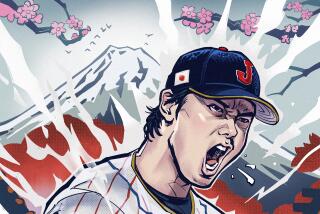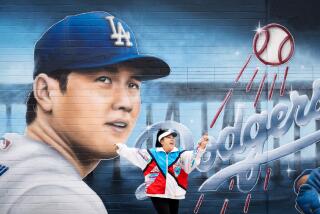CULTURE : Professor Hunts Japanese Artist’s Lost L.A. Works : Paintings produced by Yumeji, Japan’s Norman Rockwell, during a year in California are treasures that have been missing since WWII internments, scholar says.
TOKYO — In a treasure hunt that links popular Japanese culture to dark times in U.S.-Japan relations, a team of experts arrived in Los Angeles this week to search for paintings by Yumeji, one of Japan’s most popular 20th-Century artists, who had a brief Southern California sojourn.
The search for the lost works is a race against time: The last of the immigrants who knew of Yumeji and bought his art are dying, taking their secrets with them. And Yumeji’s delicate works may rot if they are not found and protected soon.
Meantime, believes Rinjiro Sodei, the professor who heads the search team, art worth hundreds of thousands of dollars languishes in the basements and garages of unsuspecting Angelenos. “To find his works, that’s my dream,” Sodei says. “I’ve been waiting 20 years to do this.”
Though he is all but unknown outside of Japan, Yumeji is, in his own nation, one of the most well-known, prolific artists. Pieces by this itinerant artist-poet--who captured the fancy of a generation of Japanese with his brightly colored, contemporary paintings--fetch from $30,000 to $100,000.
His name and his images are as much a part of the Japanese cultural consciousness as Norman Rockwell is in American minds, though much of his output is dismissed as unimportant by art historians and is aesthetically unappealing to non-Japanese.
Still, there are three museums devoted solely to his works in Japan; there have been three movies and two stage plays made about his life; there is even a coffee shop named after him in suburban Tokyo. Numerous documentaries trace his footsteps through Japan and Europe, and enough books have been written about him to fill four of Sodei’s bookshelves end to end.
But in this extensively documented life, the 13 months he spent in California, especially the Southland, gape like a black hole. Of Yumeji’s 5,000 works, almost 20 have been dated to this period. Sodei says he has found about two-thirds of these. His intensive interviews with members of the Japanese American community in Los Angeles over the past quarter of a century lead him to believe that there may be up to 30 more works.
Yumeji, experts say, went to the United States in 1931 to try to salvage his then-flagging career in Japan. He hoped to sell some of his paintings to rich Japanese American farmers in California to finance a libertine life of drinking and womanizing; he also hoped to pay his way to Paris.
Sodei says he began to learn of Yumeji’s life in the Southland in the early 1960s, while doing dissertation research on Japanese immigrants in Southern California; he found mentions of patrons and friends of Yumeji from the 1930s.
But Sodei believes that many Yumeji works were lost when--in one of the bleakest periods of U.S.-Japan relations after the Japanese attack on Pearl Harbor and the outbreak of World War II--Americans of Japanese descent were interned.
“Most of the works in California were lost because of the evacuation,” Sodei said, recalling that Japanese Americans complying with U.S. government orders “could only bring with you what you could fit in a suitcase, so people had to leave them [Yumeji paintings] behind, or with neighbors. That’s what makes this story so fascinating. Can I find them?”
In the 1970s, he tracked down Yumeji’s Los Angeles patron--an enterprising Japanese American known as “Main Mama” who ran the Hotel Elko on Main Street in Los Angeles’ Little Tokyo. Then 90, she told him of several lost Yumeji paintings she was sure were still around. She noted, for example, that a huge Yumeji painting had been displayed in her hotel’s lobby but was lost after the internment.
Sodei came upon one Yumeji oil piled in a heap of family junk in a Los Angeles garage, where it was covered with dirt and sand and had survived two floods in the building.
The problem is, no one knows what Yumeji painted in the United States, so Sodei is unsure even what he is looking for. “It is like trying to find a precious stone in a beach of sand,” he says. “But the Japanese community in Los Angeles is still close-knit, so I have hope.”
More to Read
The biggest entertainment stories
Get our big stories about Hollywood, film, television, music, arts, culture and more right in your inbox as soon as they publish.
You may occasionally receive promotional content from the Los Angeles Times.










